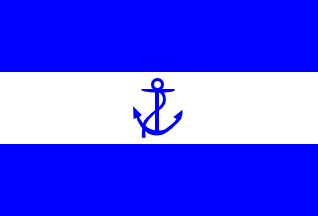 image by António Martins-Tuválkin, 13 December 2017
image by António Martins-Tuválkin, 13 December 2017
Last modified: 2021-08-25 by rob raeside
Keywords: nicaragua |
Links: FOTW homepage |
search |
disclaimer and copyright |
write us |
mirrors
See also :
Other Sites:
 image by António Martins-Tuválkin, 13 December 2017
image by António Martins-Tuválkin, 13 December 2017
This flag is attributed to Nicaragua by Emil Dreyer, W.
Crampton and The Catalan Encyclopedia. Crampton said that it was
adopted in April 1854, but this is a mistake. If exist, the flag
should be in use between 1852 and 1854.
Jaume Ollé
The 1852 flag is wrong, but there was a quite similar one in
use.
Ralf Stelter, 7 November 2000
This flag came from Emil Dreyer (in FM 22) and Crampton (in
Flags of the World). Crampton dated it in April 1854 but I moved
the date because I have the law of the flag of 1854. IMHO
in1849-1854 the federal flag was used, but I can't suppress the flag reported by Crampton because I don't have proven
information about the years 1849-1854
Jaume Ollé 11 November 2000
 image by António Martins-Tuválkin, 13 December 2017
image by António Martins-Tuválkin, 13 December 2017
National Flag - Adopted: 21 April 1854. Abolished: After some
years. Readopted: c. 1857. Abolished temporary: c. 1869. Adopted
again: c. 1873. Abolished 1889.
Jaume Ollé
 image by António Martins-Tuválkin, 13 December 2017
image by António Martins-Tuválkin, 13 December 2017
Civil (Merchant) Ensign - Ratio 2:3. Adopted: 21 April 1854.
Abolished: After some years.
Jaume Ollé
The 1854 flag was not readopted in 1857 as it was still in
legal use. The constitution of 1858 under President Tomas Marti'nez readopts the B-W-B flag for Nicaragua.
Ralf Stelter, 7 November 2000
I believe that between 1856 and 1857, the 1854 flag was de
facto out of use. Martinez (1857-67) , in general, maintained the
old style. I believe that B-W-B flag was readopted by president
Guzman, a liberal, c. 1969
Jaume Ollé, 11 November 2000
The color of the bottom stripe is defined in the law as "nacar".
Jaume Ollé, 17
December 2017
Spanish "nácar" is English "nacre" a.k.a. "mother of pearl", which
is the whitish, gleaming inner surface of most seashells. Its use as the color
of a flag area precludes a satin-like fabric, I suppose; its non metallic
equivalent would be a very light, slightly ochre tinged, light grey — maybe
RGB:255-255-204?
António Martins-Tuválkin, 17 December 2017
Ratio 2:3 Adopted: c. July 1856. Abolished: May 1857. The flag
was used by a government which was in struggle against the legal
one. The President was the American W. Walker
Jaume Ollé
The Walker flag is correct but the dates given are in
question. But it was not a national flag, as even Mr. Walker used
the Blue-White-Blue flag as national flag! He even used a Coat of
Arms similar to the later arms. Political reasons!
Ralf Stelter, 7 November 2000
I agree. In fact in this era, the B-W-B flag wasn't not
national flag at all, but only a flag of one of the parties in
the civil war
Jaume Ollé, 11 November 2000
I just saw a bit bizarre movie named "Walker". It
was supposed to tell the story of William Walker who invaded
Nicaragua in 1855 with small group of soldiers, took the capital
Grenada and appoint himself president in 1856. The film
was made in 1987 and was more then an hint to Ronald Reagan
policy in central America. In some scenes you can see a Mercedes
going by and the 1855 soldiers drink Coca Cola and smoke
Marlboro. There is even an Helicopter coming to rescue in a
Saigon evacuation style.
Nevertheless, Walker troops had a flag. a 1:4:1 red-white-red
horizontal triband, charged with 7 red stars bordered gold in
semicircle around a device (volcano?) and unreadable inscription
on the bottom red stripe. I checked the net, and the story in the
film was not following the historical facts and the film-makers
took a lot of liberty in their script. I may expect that
film-makers who send American troops in Mi-8 Helicopter, won't be
to keen to find out what flag was really used if any, and
therefore I think that the flag is more "fiction" then
reality.
About the film see www.imdb.com.
About W. Walker see www.costarica-net-guide.com
and
www.geocities.com/blackntan43/walker.william.html.
Dov Gutterman, 18 April 2005
According to
www.geocities.com/blackntan43/walker.william.html,
William Walker previously was active in Mexico and "The flag
of the Republic of Sonora was raised on the corner of Kearny and
Sacramento streets". This is the Republic
of Lower California (1853-1854)/ Republic of Sonora (1854)
Flag.
António Martins-Tuválkin, 18 April 2005
Ratio 2:3. Adopted: c. 1869 Abolished: c. 1873.
Jaume Ollé
Ratio 2:3. Adopted: 1889 . Abolished: officially it wasn't
abolished at least until 1898.
Jaume Ollé
The flag of five stripes was shown first in Le Gras' album in
1858!! It was reproduced in several encyclopedias around 1890!
So the flag was used much earlier. But when it was shown in the
1858 Album des Pavillons it must have been in use even earlier! I
assume that this flag was mistakenly shown for Nicaragua, but was
a flag of Costa Rica, when this state intervened in the Walker
affair in 1855.
Ralf Stelter, 7 November 2000
Is possible. But I read that under this flag there was an
attempt to unity the liberal and conservative parties, dated in
1889.
Jaume Ollé, 11 November 2000
The flag's use as an ensign was reported in Flags of Maritime
Nations, 1882, published by the U.S. Navy.
Ned Smith, 18 December 2007
Ratio 2:3 . The flag of the Zelaya liberal revolt, in
unofficial use since 1893. In 1896 a shield was adopted and added
to the flag.
Jaume Ollé
Ratio 2:3 Adopted: 1896. Abolished: 1 November 1898.
Readopted: 1899 Abolished: 4 September 1908, when the current
national flag was adopted.
Jaume Ollé
The 1896 flag was not a Nicaraguan flag, as Nicaragua was part
of the Republica Mayor de CA since 1895, and from 1 November 1898
part of the Estados Unidos de CA. This greater state existed
until 30 November 1898, and the old B-W-B was readopted.
Ralf Stelter, 7 November 2000
I believe that B-W-B flags was imposed after the liberal
revolution of 1893. Arms were adopted 1896 and included in the
flag. RMC was created in 1895 but dissolved after some months. The
supra state of 1898 was short lived; flag of 1895 was hoisted
1-11-1898 but some days later, after a revolt in Salvador, the
1896 flag was in use. B-W-B flag was not officialized until
4-9-1908
Jaume Ollé, 11 November 2000
 image by António Martins-Tuválkin, 11 July 2010
image by António Martins-Tuválkin, 11 July 2010
NEVA recently received a collection of 38 small flags
(11" x 17" or 28cm x 43cm) that once belonged to MIT
and probably date from the late 1950s or early 1960s. In the
collection are two custom-made copies of a flag labeled
"Nicaragua" that is three horizontal stripes of B+-W-B+
with a B+ fouled anchor in the center.
I have found an illustration
of this flag in a book by the Hydrographic Office of the U. S. Navy, the
"International Code of Signals, American Edition" (Washington: Government
Printing Office, 1923).
W. J. Gordon says in his book "Flags of the World Past and
Present-Their Story and Associations" (London: Warne, 1915)
[gor15] p. 202, "Nicaragua hoists the pale blue, white, pale blue,
horizontal, never with the white plain but with a blue anchor in
the merchant flag ..."
Does any one know more about this flag? What dates was it used?
Dave Martucci, 15 April 2009
I have only an incomplete text of the Decree dated 4 September
1908 that re-established the blue-white-blue triband, but what I
have makes no mention of any flag other than one with the
re-adopted arms in its centre.
The 1939 Flaggenbuch [neu39] gives a plain triband as the civil ensign,
but if this ever was actually (which, although certainly used, I
personally doubt) official then Law No. 1908 of 23 September
1971 (which, as far as I can find out, is the most
recent) effectively abolished same since such is not mentioned?
On the other hand, in the 50's and 60's (and before of course) a
flag containing the arms would be comparatively expensive to
purchase, so the existence of simpler designs - coming into
unofficial favour by popular demand - makes sense, do it not?
Christopher Southworth, 15 April 2009
The anchor bearing flag is shown in the on-line 1912
Lloyds Flags & Funnels for "Merchant Vessels" [llo12].
It still appears in the 1923 French 'Album des Pavillons
Nationaux et des Marques Distinctives" [f9r23].
The 1934 Italian 'Raccolta delle Bandiere...' [i9t32] also shows it.
Earliest use found was 1907 in 'Drawings of the Flags in Use at
the Present Time by Various Nations' [hms07].
Jan Mertens, 15 April 2009
The B-W-B Nicaraguan flag with the blue anchor was produced in Germany. Yes,
in around 1905 a German manufacturer produced flags for Nicaragua, and one of
them was that civil ensign with an anchor. But while on the way the manufacturer
realised that this flag was not correct, and so on board of that ship all
anchors had to be removed. This was told to me by Dr. Otfried Neubecker who
helped me to build up my Archiv für Flaggenkunde.
Ralf Stelter, 01 March 2014
I came across this link on the Nicaragua Living site about a Sandino flag
which seems to precede the "rojonegra" flag with the skull & bones.
http://www.nicaliving.com/node/15682
James Ferrigan, 26 September 2011
It is a bit strange that if this so called "captured flag" was indeed used by
Sandino himself or his militia, one can read the inscription "COCO RIVER" in
English, inside the black star, when the native official language of Nicaragua
is Spanish. Below "COCO RIVER" one can also read a date, to me it looks like
"1928", part of the era when the occupation occurred (1927-1933).
Esteban Rivera, 26 September 2011
That might be related to the "REGT" and "USMC" above it. I don't know
anything about what happened at that river, but might the marines have added the
text to the flag after they capture it? Or might the commander who kept it have
added it later to indicate what it was?
I can't see whether there is a number for this regt., nor do I know whether
there should be one. Or it must be whatever it says below the year, that can't
make heads or tails of. Anyone with good eyes? I don't know. Hanging them in
churches seems to keep flags in one piece longer. But then again, they tend to
lack such little explanatory notes that way.
Peter Hans van den Muijzenberg, 26 September 2011
The inscription reads, "5 REG'T USMC COCO RIVER 1928 NIC'A" Presumably put
there to mark the trophy after capture.
My question is when did the red & black flag with the skull & bones evolve? The
one that was captured in 1932 The summer of 1928 operations on the Coco River
resulted in a large capture of materiel & presumably this flag. We also
know the Sandino guerrillas utilized red & black scarves and kerchiefs.
Was a flag prescribed for Sandino's Ejército Defensor de la Soberanía Nacional
de Nicaragua?
James Ferrigan, 27 September 2011